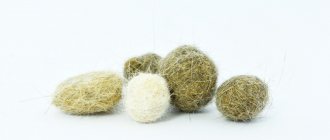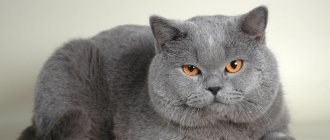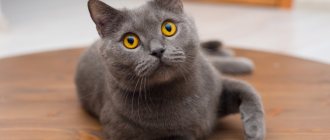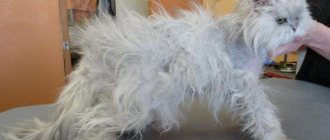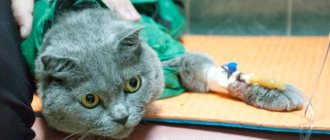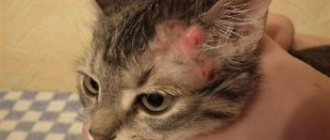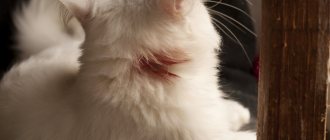The vet talks about the problem!
Have you noticed dry scabs or flaky spots on your pet's skin? Or maybe you're anxiously examining the hard red nodules under your pet's fur? What it is and how to deal with it – we will tell you in this article.
Nowadays, most cats live in the artificial environment of apartments and houses. They eat dry food (check out the good ones), sleep on the couch, look out the window and have virtually no contact with the outside world. It would seem: excellent conditions for a long life without disease.
But in reality, the opposite happens: furry friends become more susceptible to infections and parasites, and they develop allergies.
Many of the diseases that domestic cats suffer from include skin rashes of various shapes, colors and locations as one of the symptoms.
In this article we will tell you about what could cause the appearance of dry sores on the skin of a cat, how to diagnose it and, finally, how to treat the identified disease.
The structure of animal skin
The skin is the largest organ of a cat, the weight of which, depending on the species, age, and nutrition of the animal, ranges from 12 to 24% of its weight. It protects internal organs from the negative effects of the external environment, regulates body temperature, acts as an organ of touch, and performs other important functions.
The skin of a cat consists of three layers:
- epidermis;
- dermis;
- subcutaneous tissue.
Epidermis
The outer layer of the skin is the epidermis, consisting of keratinized scales. It is constantly updated. The scales leave the body when they are pushed out by young cells coming from below (the process of keratinization).
The layer is durable, elastic, capable of retaining water, salts, nutrients, and preventing infection from entering the body. There are also cells associated with whiskers and hair follicles that improve the sense of touch.
It is the epidermis that is damaged more often than others. With weak immunity, he may succumb to infection and sunlight. Fleas and ticks attack him first, gnawing holes.
basement membrane
The epidermis is separated from the next layer, the dermis, by a thin basement membrane. It is involved in cell regeneration and affects their metabolism. The elasticity of the cover depends on its integrity. Some diseases of the epidermis, as well as a number of autoimmune skin diseases of cats and dogs, can damage the membrane and disrupt its functions.
Dermis
The dermis produces collagen, which maintains skin tone. Also here is:
- A network of blood vessels through which the dermis nourishes the epidermis, fur, claws, and regulates body temperature.
- Sensory and motor nerves through which the body reacts to cold, heat, itching, pain.
- Immune cells that trap infectious agents that have been able to pass through the epidermis.
Subcutaneous layer
Subcutaneous tissue is the innermost layer. It contains subcutaneous fatty tissue, which provides insulation, is a shock absorber, and a reservoir for liquids, electrolytes, and glucose.
Wool
One of the appendages of the skin is wool. Hair follicles in adult pets are complex - they have a central hair surrounded by small hairs that come from one common pore.
Their growth and condition are affected by nutrition, hormones, molting, and health. The sebaceous glands secrete a secretion that moisturizes the skin and makes the coat soft and shiny. The color of the coat can vary depending on the time of year, temperature changes, and the amount of sunlight.
Wool protects the animal's skin from physical damage and ultraviolet radiation. It helps regulate body temperature, so it's longer in winter. In summer, the coat is not only shorter, but also has fewer secondary hairs, allowing air to pass through it calmly, cooling the skin.
Cat claws
Another appendage is the claws. The cat uses them as a tool for protection, catching prey, holding meat, and climbing. By contracting the tendons, it can retract or extend them back and forth.
Shedding
If a cat's fur falls out in clumps, the reasons may be very trivial. Animals in the wild change their coat twice a year: in autumn and spring. In domestic animals, this process is disrupted, since they are removed from their natural habitat. For example, in the fall, when all animals in nature build up a warm undercoat for winter, the reverse process begins in domestic cats.
This is due to the fact that the heating is turned on during this period of time. The air in the apartment becomes hot and dry, so your pet is in a hurry to get rid of excess fur. Moreover, at home, the molting process can take much longer than in natural conditions. This is completely normal. The fact that an animal is actively changing its coat is not a cause for concern.
All you need to do is make sure that your cat's diet is balanced and rich in vitamins and minerals. If there are not enough of them in the diet, you can compensate for this deficiency. It is enough to purchase special vitamin and mineral complexes at any pet store.
You need to comb the animal more often. On normal days, sessions should be carried out once every 7-30 days, but when the molting period begins, the procedure becomes daily. And if your pet has long hair, you will have to comb it twice a day. And even this will not get rid of the daily use of a vacuum cleaner.
Causes of skin diseases in cats
Poor care, poor diet, stress, medications, plastic bowls - in veterinary medicine, animal skin diseases can be caused by various reasons. When a pet is sick or frequently encounters an irritant (eg, an allergen), its immunity weakens. She becomes vulnerable to opportunistic organisms that always live in her body (for example, dermatitis mites) and do not normally appear.
Other causes of skin diseases in cats:
- allergies to food, inhaled compounds, flea bites and other substances with which the pet comes into contact;
- communication with sick animals;
- fungal infections;
- bacterial disease of the hair follicles;
- trauma, skin damage, causing inflammation or abscess;
- adverse reactions to medications;
- fleas, ticks;
- hormonal imbalances.
Skin diseases of cats: general symptoms
There are a number of symptoms of skin diseases that will indicate a problem, regardless of the cause:
- severe itching;
- hair loss, bald patches;
- redness;
- dryness, peeling, scabs;
- dull coat color.
The animal constantly itches, scratches, and chews its skin to reduce the pain of symptoms of skin diseases in cats. She may also lick the fur too much to soothe the irritated coat.
Veterinarian advice
Despite the risks of being outside, the cat needs fresh air, so you should not limit its freedom. Since infections and parasites are transmitted through hands or from other animals, preventative treatment against parasites should be carried out regularly.
Veterinarian advice:
- The animal must be kept clean.
- A good immune system will protect your cat from any infection. The key to health is proper and balanced nutrition.
- To prevent allergies, you should not include smoked and salty foods in your diet. Sweets are also prohibited.
- A change of owner or a sharp change in attitude towards a pet leads to stress and illness. A pet needs to be loved, cared for, and given enough attention.
Be sure to read:
What to do if a cat licks its fur to bald spots and wounds, what is overgrooming
A signal about the development of the disease can be constant licking of fur, scratching and excessive attentiveness to one’s appearance. Often the cat owner thinks that the pet has fleas, but when examining the fur, it is clear that this is not the reason.
Possible causes of itching:
- allergy;
- fungal diseases;
- hormonal diseases;
- hypo- and vitamin deficiencies;
- change of diet.
Sometimes itching occurs for psychogenic reasons. Increased licking and scratching occurs when the animal is stressed. This is often observed when an individual requires mating. Taking sedatives will help calm your pet.
Cats always try to lick wounds, sores and other skin lesions. After sterilization, a seam remains, which itches and itch, so the animal scratches and licks it. To prevent bleeding or other serious complications, a surgical collar is placed on the cat.
It can be difficult to diagnose why an animal constantly licks itself. First, the cat is checked for fleas, then it is analyzed whether the diet or care products have changed.
With a skin disease, the animal often shakes its head and licks itself until it bleeds. Only a doctor can diagnose the disease, so the pet must be taken to the clinic immediately. Based on the scrapings taken, they will be able to identify mites or fungal spores.
READ North Caucasian pigeons, Caucasian pigeons (photos and videos)
Types of skin diseases in cats
The classification of skin diseases in cats is based on the cause of the disease. Mainly found:
- allergic dermatitis;
- fungal infection;
- bacterial infection;
- parasitic infection;
- psychogenic factor.
Dermatitis
Cutaneous dermatitis in cats is a group of diseases associated with inflammatory disease of the skin. Their cause is allergies, age, genetics, trauma. The group includes:
- allergic dermatitis;
- eczema;
- toxicerma - exposure to toxic substances circulating in the blood (medicines, chemicals);
- atopic dermatitis - hereditary skin diseases in cats;
- hives.
Dermatitis in cats has characteristic symptoms. Kittens develop purulent blisters on the face, stomach, and groin. In adult pets, spots appear in the area of the knee joints, along the back. Papules and acne are visible.
How to treat dermatitis in a cat
Saphroderm gel is prescribed for the treatment of dermatitis in cats. The medicine quickly relieves inflammation, heals wounds, and has an antiseptic effect. It helps against eczema, trophic ulcers and other skin inflammations of a non-infectious nature.
Also, for the treatment of dermatitis in cats, the following medications are prescribed:
- Imunofan (NPP Bionox) in ampoules. The hormonal drug restores impaired immune function and acid-base balance.
- Stop-Itching for cats (Api-san), bottle. 10 ml. The suspension relieves itching, inflammation, improves blood circulation in tissues. The drug contains B vitamins, which promote cell restoration.
- Hepatovet Active (Api-San) for cats, bottle. 25 ml. The drug improves the functioning of the liver, which is responsible for processing poisons, incl. – neutralization of allergens.
Allergic dermatitis
Allergies develop when a pet's immune system reacts too strongly to foreign substances that have entered the body. The reaction often occurs to fleas, a certain food item, airborne particles, or objects that the animal comes into contact with (a bowl).
The main allergic signs of skin diseases in cats:
- itching, due to which the animal constantly itches, rubs, shakes its head, gnaws its paws, in the tail area;
- red rash, bumps;
- hair loss, baldness;
- runny nose, drooling;
- fever;
- vomiting, diarrhea, gas, or bloating;
- sneezing, coughing, wheezing.
- swelling, anaphylactic shock, death (in severe cases).
What to do?
For cat skin disease, treatment often involves a hormonal injection to relieve the itching. But this is only a temporary measure. When the medicine wears off, the disease will return.
Therefore, if signs of allergic dermatitis are detected in cats, it is necessary to calculate or eliminate the allergen - change the diet, treat for fleas, buy a bowl or bedding made of high-quality material. If the source cannot be detected, the pet’s blood must be tested to determine the irritant.
The following will help relieve allergies at home:
- Immunofan – improves immunity;
- Stop-Itching suspension – relieves scabies
- Hepatovet – strengthens the liver, which helps it process toxins.
Fungal infections
Fungi are microorganisms that reproduce by spores by eating host cells. Over time, they penetrate into the deep layers of the skin, become fixed, after which it is not easy to destroy them. In advanced cases, they can even enter the bloodstream and poison the body.
There are many fungi in the world, but only a few cause disease. The main cause of infection is direct contact of the skin (fur) with the fungus. Some organisms constantly live on the skin, without showing themselves in any way, and are activated when the body weakens.
The following types of fungal skin diseases in cats can be distinguished:
- Aspergillosis - affects the respiratory system, nose. The infection develops against a background of stress and weakened immunity. May manifest as swelling of the muzzle, pneumonia.
- Candidiasis - affects the skin and mucous membranes of the mouth, nose, and eyes.
- Cryptococcosis – damages the respiratory tract (especially the nasal cavity), brain, eyes, face and neck. Cats often become infected by pigeons by inhaling bird droppings. Symptoms include bloody, purulent nasal discharge, soft or hard nodules on the skin that can develop into ulcers, depression, seizures, paralysis, and blindness. Lack of treatment can cause death.
- Mycetomas are a fungal disease of the subcutaneous tissue, as a result of which small nodules appear on the face and paws.
A dangerous disease is ringworm. This is a highly contagious disease caused by the fungus dermatophyte. It appears on the face, ears, tail, and feet in the form of bald patches covered with crusty scales. The fur around them is dull, with broken hairs. Sometimes small, hard bumps appear, causing itching. They can develop into large bumps with ulcers.
Fungal skin diseases of cats and their treatment
Before treating the disease, it is necessary to determine the type of fungus. A medicine designed to eliminate one parasite does not always cope with another. To do this, the veterinarian takes a sample of the damaged tissue for examination. If the analysis fails, you can use a universal medicine developed for different types of fungi.
The following drugs will help eliminate the disease and prevent its occurrence:
- Vakderm is a vaccine that will protect against ringworm and some other types of fungi.
- Gamavit is a drug that strengthens the immune system, helping the body fight fungal infections.
- Fungin forte spray is effective for ringworm, as well as for diseases caused by Trichophyton, Microsporum, Epidermophyton, Achorion.
- Yam BK ointment is used to treat various types of fungi and eczema. It has antiseptic, keratolytic, astringent properties.
Parasitic skin diseases in cats: how to treat them
The most common parasitic disease is fleas, which live on the skin and hide behind the animal's fur. The main symptom is that the pet itches and chews itself. As infection progresses, the itching intensifies.
It used to be difficult to get rid of fleas. Now the problem is solved with the help of drops, sprays, tablets, and special collars. For skin diseases in cats, the following drugs are prescribed:
- Bass Forte;
- Celandine Spray;
- Blokhnet;
- Delcid;
- Celandine C325, shampoo.
Scabies is a parasitic skin disease. Its cause is mites, so small that they cannot be seen without a microscope. Females dig holes in the animal's skin, causing itching. Another symptom of the disease is baldness in the affected area.
Just a few years ago, scabies and demodicosis were considered an incurable disease. Now the course of skin disease in animals can be controlled with the help of tablets, drop injections, sprays - Advocate, Ivermek, etc. “Stop-Itch Suspension” will help relieve scabies.
Seborrhea
Seborrhea in a cat is a condition when dandruff (dry form) appears on the animal’s fur, the fur is glued at the base, and there are plaques on the skin (oily). It develops due to increased activity of the sebaceous glands, caused by hormonal imbalance, mites or poor nutrition.
What to do?
To rid your pet of seborrhea, normalize his diet, take a hormone test, and adhere to the prescribed treatment. The following products will help improve skin condition and eliminate diseases:
- Essential 6 spot-on (LDCA). Contains essential oils that irritate, soothe and moisturize sore skin. The method of use is simple - apply the product to the skin near the shoulder blades, after which it will distribute itself throughout the epidermis.
- 8in1 Excel Brewers Yeast with brewer's yeast and garlic. The complex supplement contains useful substances, B vitamins, Omega-3, which have a good effect on the skin and coat.
Ulcers
More often, ulcers occur in short-haired four-legged friends. They can appear along the entire length of the tail, often affecting the root, and this can cause necrosis of the tissues and vertebrae of the tail.
An ulcer on the tail requires serious treatment and attention from the owner. If a crust has formed on it, then it must be removed from there and the wound must be cleaned of suppuration. Be sure to treat everything with an antiseptic for cats. Also, it is worth treating it with ointment (Vishnevsky, streptomycin) and applying a bandage.
© shutterstock
In advanced cases, the cat may develop gangrene, blood poisoning and serious consequences.
Preventive measures for skin disease in cats
- Get the vaccine against fungal diseases (Vakderm) on time.
- Don't let your cat go outside. A pet that walks without control may well come into contact with sick animals.
- Support your pet's immunity. For prevention, give medications to strengthen the liver (Hepatovet) and immunity (Immunofan).
- Give the animal only high-quality food, do not overfeed.
- Consult a doctor at the first symptoms of cat skin diseases and begin treatment immediately.
Poor nutrition
At any age, the animal's diet must be balanced. Feeding from your own table is the most common mistake a pet owner makes. With this approach, the animal’s bowl may contain everything that is strictly prohibited for cats: fried foods, sausages, various scraps, leftover salty and fatty foods.
The answer to the question of why a cat's fur falls out in clumps may be a simple desire to save money. For example, the owner buys dry food from the cheapest line. Yes, such food will help your pet get enough, but it will also bring many health problems. After all, its composition is not always optimal, so the effect of such food on the animal’s body can be destructive.
It is worth understanding that choosing a diet is a very important process. It is better to choose dry food from the super-premium or premium category. This diet is balanced and contains all the necessary microelements. Although it costs, of course, more than advertised budget products. But using low-quality food will cost much more, as it will provoke a trip to the veterinarian and long-term treatment.
To determine why a cat’s hair is falling out in clumps, and to understand that the reason lies precisely in the food and improper diet, it is necessary to take into account the following symptoms:
- the main pieces of hair fall out on the back, neck and tail;
- on all other parts of the body the fur began to fade;
- discharge appeared from the eyes, and they themselves became cloudy;
- the ears are inflamed and itchy;
- The bald spots that have arisen at the site of the fallen tufts are inflamed and itchy, the layers of skin in these places have begun to peel off, the animal scratches itself so that sores appear.
Treatment
Once the cause of dermatitis is identified, appropriate therapy is prescribed. It is also worth considering information about medications taken if the cat is undergoing parallel treatment for some other diseases.
- To get rid of fleas, ticks and lice, preparations containing pyretin are used. Sulfur and Aversectin ointment, Advocate drops, Amit Forte show good results in practice. The affected areas of fur are cut off. In addition to ointments and aerosols, various baths, lotions and intramuscular injections can also be prescribed.
Important: one of the components of therapeutic therapy is measures to disinfect the animal’s area of residence.
- Ringworm is treated with products that contain fungicides. As in the case of skin parasites, it is necessary to pay special attention to disinfecting the premises where the animal lives, as well as to protect other pets from it.
- Food allergies are eliminated by eliminating potentially dangerous foods from the daily diet. Additionally, it is recommended to take antihistamines and agents that cleanse the body of toxins and intestinal parasites. In particular, we can talk about homeopathy and dietary supplements. Bathing with special shampoos is recommended.
- If a fungal or bacterial infection is detected, antibiotics are prescribed, the dosage regimen of which must strictly comply with medical prescriptions. Benadryl helps relieve itching.
- In case of autoimmune diseases, steroid drugs are used - analogues of Prednisone. Treatment often consists of several stages, when at the beginning the body receives large doses of the drug, and then its amount is progressively reduced.
Allergy
In most cases, as in humans, an allergic reaction in an animal manifests itself on the skin. The hair falls out symmetrically in parallel, redness appears on the skin, and the ears become inflamed and itchy. Most often, allergies are caused by some food product, including feed. In such cases, the diet is simply adjusted.
But the problem may not always be food. Allergies can occur to grooming products or to the material from which the bedding or bowl is made. If the allergy is not related to food, you need to temporarily limit the animal from all its things. After the allergy has stopped, you should return one item at a time and carefully observe, after which the allergic reaction will appear again. Accordingly, this item will subsequently need to be removed from the cat’s everyday life.
Video “Depriving cats”
One of the reasons that your cat has patches of baldness on his back may be the previously discussed lichen, which is what the next video is about!
Sorry, there are no surveys available at this time.
Was this article helpful?
Thank you for your opinion!
The article was useful. Please share the information with your friends.
Yes (50.00%)
No (50.00%)
X
Please write what is wrong and leave recommendations on the article
Cancel reply
Rate the benefit of this article: Rate the author ( 14 votes, average: 4.21 out of 5)
Discuss the article:
